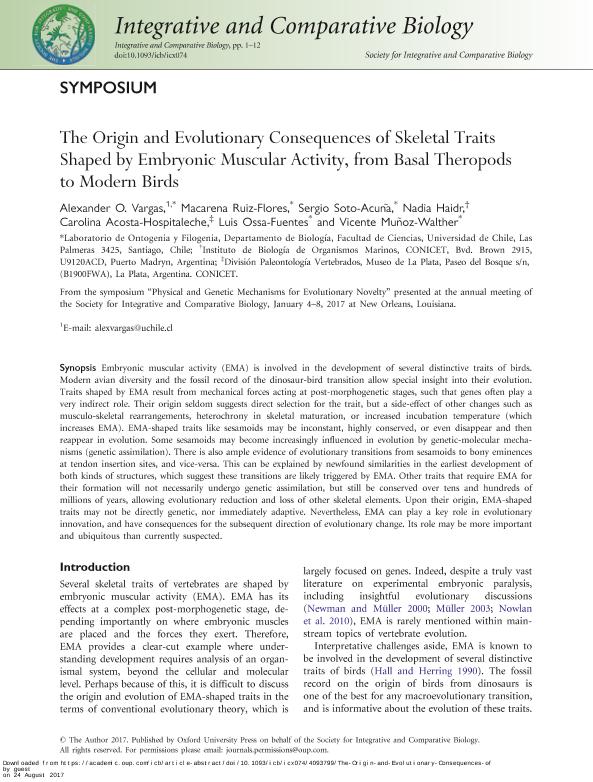Mostrar el registro sencillo del ítem
dc.contributor.author
Vargas, Alexander O.
dc.contributor.author
Ruiz Flores, Macarena
dc.contributor.author
Soto Acuña, Sergio
dc.contributor.author
Haidr, Nadia Soledad

dc.contributor.author
Acosta Hospitaleche, Carolina Ileana Alicia

dc.contributor.author
Ossa Fuentes, Luis Andrés

dc.contributor.author
Aguayo Muñoz, José Fernando

dc.date.available
2018-02-22T14:57:38Z
dc.date.issued
2017-12-01
dc.identifier.citation
Vargas, Alexander O.; Ruiz Flores, Macarena; Soto Acuña, Sergio; Haidr, Nadia Soledad; Acosta Hospitaleche, Carolina Ileana Alicia; et al.; The Origin and Evolutionary Consequences of Skeletal Traits Shaped by Embryonic Muscular Activity, from Basal Theropods to Modern Birds; Oxford Univ Press Inc; Integrative And Comparative Biology; 57; 6; 1-12-2017; 1281–1292
dc.identifier.issn
1540-7063
dc.identifier.uri
http://hdl.handle.net/11336/36961
dc.description.abstract
Embryonic muscular activity (EMA) is involved in the development of several distinctive traits of birds. Modern avian diversity and the fossil record of the dinosaur-bird transition allow special insight into their evolution. Traits shaped by EMA result from mechanical forces acting at post-morphogenetic stages, such that genes often play a very indirect role. Their origin seldom suggests direct selection for the trait, but a side-effect of other changes such as musculo-skeletal rearrangements, heterochrony in skeletal maturation, or increased incubation temperature (which increases EMA). EMA-shaped traits like sesamoids may be inconstant, highly conserved, or even disappear and then reappear in evolution. Some sesamoids may become increasingly influenced in evolution by genetic-molecular mechanisms (genetic assimilation). There is also ample evidence of evolutionary transitions from sesamoids to bony eminences at tendon insertion sites, and vice-versa. This can be explained by newfound similarities in the earliest development of both kinds of structures, which suggest these transitions are likely triggered by EMA. Other traits that require EMA for their formation will not necessarily undergo genetic assimilation, but still be conserved over tens and hundreds of millions of years, allowing evolutionary reduction and loss of other skeletal elements. Upon their origin, EMA-shaped traits may not be directly genetic, nor immediately adaptive. Nevertheless, EMA can play a key role in evolutionary innovation, and have consequences for the subsequent direction of evolutionary change. Its role may be more important and ubiquitous than currently suspected.
dc.format
application/pdf
dc.language.iso
eng
dc.publisher
Oxford Univ Press Inc

dc.rights
info:eu-repo/semantics/openAccess
dc.rights.uri
https://creativecommons.org/licenses/by-nc-sa/2.5/ar/
dc.subject
Embryonic Muscular Activity
dc.subject
Aves
dc.subject.classification
Otras Ciencias Biológicas

dc.subject.classification
Ciencias Biológicas

dc.subject.classification
CIENCIAS NATURALES Y EXACTAS

dc.title
The Origin and Evolutionary Consequences of Skeletal Traits Shaped by Embryonic Muscular Activity, from Basal Theropods to Modern Birds
dc.type
info:eu-repo/semantics/article
dc.type
info:ar-repo/semantics/artículo
dc.type
info:eu-repo/semantics/publishedVersion
dc.date.updated
2018-02-22T14:30:55Z
dc.journal.volume
57
dc.journal.number
6
dc.journal.pagination
1281–1292
dc.journal.pais
Reino Unido

dc.journal.ciudad
Oxford
dc.description.fil
Fil: Vargas, Alexander O.. Universidad de Chile; Chile
dc.description.fil
Fil: Ruiz Flores, Macarena. Universidad de Chile; Chile
dc.description.fil
Fil: Soto Acuña, Sergio. Universidad de Chile; Chile
dc.description.fil
Fil: Haidr, Nadia Soledad. Consejo Nacional de Investigaciones Científicas y Técnicas. Centro Científico Tecnológico Conicet - Centro Nacional Patagónico. Instituto de Biología de Organismos Marinos; Argentina
dc.description.fil
Fil: Acosta Hospitaleche, Carolina Ileana Alicia. Universidad Nacional de la Plata. Facultad de Ciencias Naturales y Museo. División Paleontología Vertebrados; Argentina
dc.description.fil
Fil: Ossa Fuentes, Luis Andrés. Universidad de Chile; Chile
dc.description.fil
Fil: Aguayo Muñoz, José Fernando. Universidad de Chile; Chile
dc.journal.title
Integrative And Comparative Biology

dc.relation.alternativeid
info:eu-repo/semantics/altIdentifier/url/https://academic.oup.com/icb/article-abstract/57/6/1281/4093799
dc.relation.alternativeid
info:eu-repo/semantics/altIdentifier/doi/http://dx.doi.org/10.1093/icb/icx074
Archivos asociados
